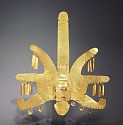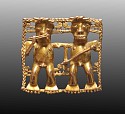


Colombia, 3 Muisca Cast Gold Snakes
The Muisca people of Eastern Columbia were known for their famous myth, El Dorado. El Dorado refers to a lord riding on a golden raft and covered in gold dust. Serpents are featured prominently in the Muisca creation myth, which describes two snakes emerging from the Iguaque lagoon as a women and child. Transmutation was an important theme to the Musica; these snakes are all cast using the lost wax technique as well as the manipulation of alloys to create the three different hues of gold.
Period: Colombia, Muisca, c. AD 700 - 1500
Media: Metal
Dimensions: Length: 1. 7/8, 2. 3/16 & 3. 9/16 inches Total Weight: 5.2 grams.
$2,400
n8006





Colombia, Calima Cast Gold Lime Dipper of a Warrior with Animal Perched on Back
This finely cast gold lime dipper features a warrior with an animal perched on his back and a tapering shaft terminating in two bands of granulation. The warrior wears an elaborate mask, a curving headdress, and holds a staff with both hands. Gold lime dippers often featured warrior figures and were reserved for important personages. For further reading, see Calima and Malagana, by Marianne Cardale Schrimpff. A similar lime spoon is illustrated on p. 115, plate 111.34. This is an excellent example of lost wax casting. Acquired in 2000 from private New York collector.
Period: Colombia, International style, AD 700 - 1000
Media: Metal
Dimensions: Length:(8 1/4" Weight 15.9 grams.
$12,000
MM618
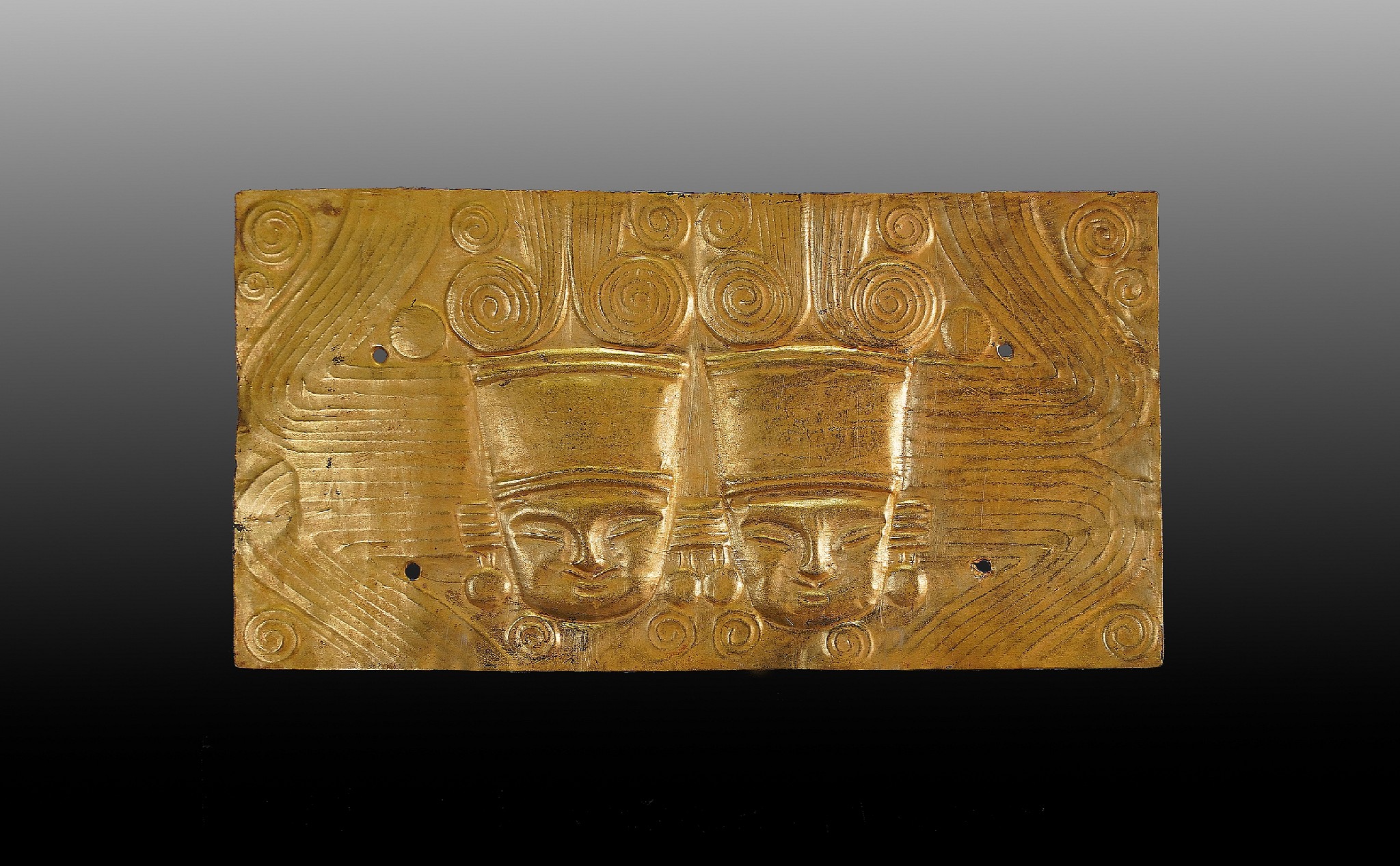
Colombia, Calima Gold Hammered and Incised Plaque with Two Royal Heads
In ancient Pre-Columbia, twin imagery was considered to represent good luck and prosperity. This incised gold plaque features twin royal figures, identifiable by their headdresses and the elaborate swirl design above their heads, indicating that they are individuals of high status.
Period: Colombia, Calima, c. AD 700 - 1200
Media: Metal
Dimensions: Height: 3 1/2" x Width: 6 1/2" Weight 28.8 grams.
$24,000
p5051






Colombia, Calima Gold Lime Spoon with a Royal Bird Holding a Double-Headed Serpent
When held upside down, this elaborately crafted bird transforms into a mask. From the Jan Mitchell collection, acquired prior to the 1970s, by descent to his sons.
Period: Colombia, Calima, c. AD 600 - 1000
Media: Metal
Dimensions: Height: 4 1/8" Weight: 22.7 grams.
$7,500
p1052






Colombia, Calima Gold Tupu (Lime Dipper) of a Deity Seated on a Serpent
The deity has an elaborate face mask and holds the tail of the serpent upon which he is seated. This is a known motif, but rarely seen with a human, as most are found with a cayman or feline as the primary figure. According to the research, only limited types of images were used for lime dippers, usually shamans or warriors. A similar example is illustrated in Calima and Malagana, by Marianne Cardale Schrimpff, page 116, plate 111.37.
Period: Colombia, Calima, Yotoco Phase, Cauca River Valley, c. AD 100 - 1000
Media: Metal
Dimensions: Length:5 1/4 " x Weight: 34 grams.
$8,250
M8031





Colombia, Calima Rayed Gold Headdress Ornament with an Embossed Face
Similar style headdress ornaments are in the gold Museum in Bogota. It appears that the ornament was ceremonially "killed". Ex. Jan Mitchell collection, prior to 1970, by descent to his sons. From a Texas collector, acquired prior to the 1970s.
Period: Colombia, Calima, Yotoco Phase, Cauca River Valley, c. AD 100 - 1000
Media: Metal
Dimensions: Height 10 1/2"
$28,500
P1001





Colombia, Calima Tupu with Condor on top
Tupus were used to fasten the shawls of upper class women as well as the garments on votive offerings of small figures. The tops were often decorated with images which related to its owner, such as a Shaman, Cacique (warrior) or favorite animal. This tupu has the condor's male snood and incised feathers on the wing and tail.
Period: Colombia, Calima, Yotoko phase, lower Cauca valley circa AD1200-1300
Media: Metal
Dimensions: Length 9 1/8" Weight: 45grams
Price Upon Request
M8033



Colombia, Capuli Hammered Gold Pectoral Disk
This pectoral has two sets of horizontal suspension holes toward the top. The suspension holes suggest that the disc was originally part of a more elaborate stringing with multiple strands. A very similar pectoral with four suspension holes is illustrated in THE ART OF PRECOLUMBIAN GOLD: The Jan Mitchell Collection, page 202. From the estate of Jan Mitchell, acquired prior to the 1970s.
Period: Ecuador, Capulio, Northwestern, c. AD 700 - 1200
Media: Metal
Dimensions: Diameter: 3 3/4 " Weight: 44.6 grams.
$6,500
p3062




Colombia, Chiriqui /Diquis Gold Pendant with Framed Twin Musicians
Gold pendant with twin musicians, side by side. There are two sets of Saurian animals in profile, along the figures’ heads and knees, encircled by the typical braided goldwork frame. Illustrated in The Art of Pre-Columbian Gold, page 102, and exhibited in 1976 in the Leningrad Museum. Also published in Pre-Columbian Art of Mexico and Central America, 1968, by Hasso Von Winning, plate #189 on page 378. From the estate of Jan Mitchell, by descent to his son Oliver Mitchell, prior to 1968.
Period: Panama, Diquis, c. AD 700 - 1550
Media: Metal
Dimensions: Height: 2 7/8 x Width: 3 in. Weight: 116 grams.
$85,000
p4165










Colombia, Darian Cast Gold Smiling Shaman with Headdress of Two Hemispheres with Spirals
This is a very large example of a Darien pendant with strong influences of neighboring Sinu and Quimbaya styles. The shaman has the typical Darien hemispherical headdress with filigree spirals, and a zoomorphic triangular snout that shows two rows of teeth. The projecting side ornaments are intended to represent a headdress made of feathers and are adorned with additional spiral scrolls. The legs are represented by a single metal plaque with curved sides and a vertical groove in the center – a stylistic influence from the earlier Quimbaya culture. Two similar images are illustrated in Darien Gold Pendants of Ancient Columbia and the Isthmus, by Ana Maria Falchetti -figures 30 and 31 on page 49.
Period: Colombia, Darian/Sinu, Northern Region, circa AD1-500
Media: Metal
Dimensions: Height: 5"(12.7cm) x Width: 3 3/4"(9.5cm) Weight: 187.5grams. (6 troy oz)
$150,000
n6003



Colombia, Darien Tumbaga Classic Mushroom Style Figural Pendant
This pendant is published in The Darien Gold Pendants of Ancient Colombia and the Isthmus, by Anna Maria Falcetti, Metropolitan Museum Journal No. 43, 2008, page 39. There is a high amount of gold in the casting. Ex-Jan Mitchell collection, prior to 1970.
Period: Colombia, Darian/Sinu, Northern Region, c. AD 400 - 1500
Media: Metal
Dimensions: Height: 2 5/8" x Weight: 36.2 grams.
$14,000
P1016






Colombia, Early Calima Gold Forged Maskette of a Deity with Dangles
This is a second type of a Calima face that appears less frequently. The features are reduced to the essentials: a small, modeled nose and brow, hemispherical eyes, and a rectangular mouth with prominent teeth. A slightly smaller gold face (9 centimeters) is illustrated in CALIMA AND MALAGANA, by Marianne Cardale Schrimpff, page 170. There are dangles for the eye, ears, and chin; the illustrated Maskette is missing the eye dangles. Ex. New York collector, prior to 1970.
Period: Colombia, Calima, Llama Phase, Cauca River Valley, c. 100 BC - AD 400
Media: Metal
Dimensions: Height: 3 3/4"(9.5cm) x Weight: 39 grams.
Price Upon Request
P1005
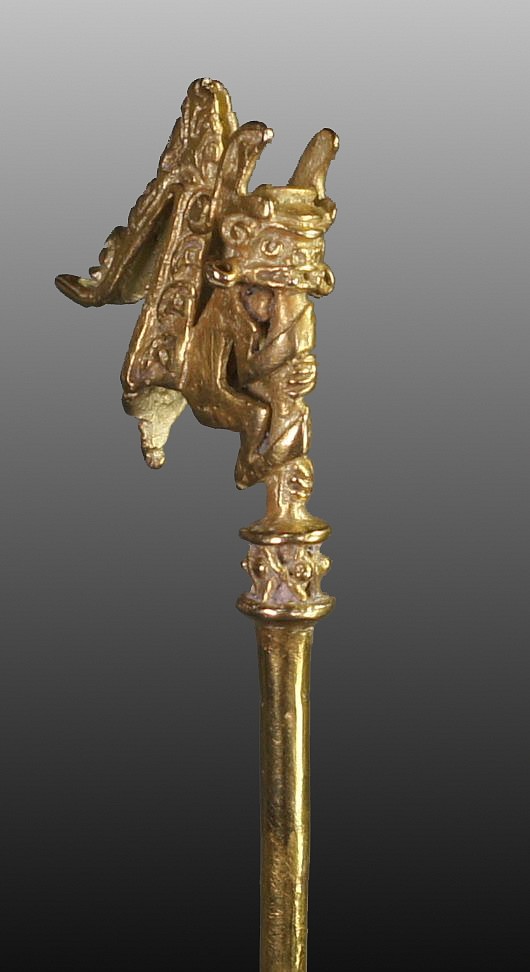



Colombia, Early Calima Gold Lime Dipper
A fine lost wax cast lime dipper with a mythological monkey deity on the tip. The monkey wears a helmet, ear spools, and an elaborate headdress which falls down the back of his body. Lime dippers were used to mix lime with crushed leaves from the Erythroxylum coca plant (from which cocaine is derived) to create a drug compound that functioned as a psychoactive stimulant used in ritual ceremonies. According to the research, only limited types of imagery was used for lime dippers, usually shamans or warriors. See Calima and Malagana, by Marianne Cardale Schrimpff for further reading. A similar but not exact motif is also illustrated in Orfebreria Prehispanica de Colombia on page 84, plate # 5232.
Period: Colombia, Calima, Yotoco Phase, Cauca River Valley, c. AD 100 - 1000
Media: Metal
Dimensions: Length: 8 1/2" Weight: 25 grams.
$9,500
97146





Colombia, Early Calima Pair of Gold Hour-Glass Shaped Ear Spools
These spools are made from high karat gold sheets formed on balsa wood cores. The side seams were nailed shut, and the circular ends were crimped to the sides. These ends of the spools have embossed designs radiating around the central shaft. This style of earspool was worn in the ancient Americas by hanging from the ear lobe, suspended by a cord through the shaft. These were clearly intended to be a pair, weighing only a 1/2-gram difference. A very similar pair is illustrated in THE ART OF PRECOLUMBIAN GOLD: The Jan Mitchell Collection, page 194. Ex-collection Jan Mitchell, acquired prior to the 1980s.There are dents in the spool, and separated crimped edges.
Period: Colombia, Calima, Yotoco Phase, Cauca River Valley, c. AD 100 - 5000
Media: Metal
Dimensions: Height:2 1/4 " x Diameter: 2 " Gram Weight: 12.5 & 13 grams. each (total 25 grams.)
$8,500
p3066
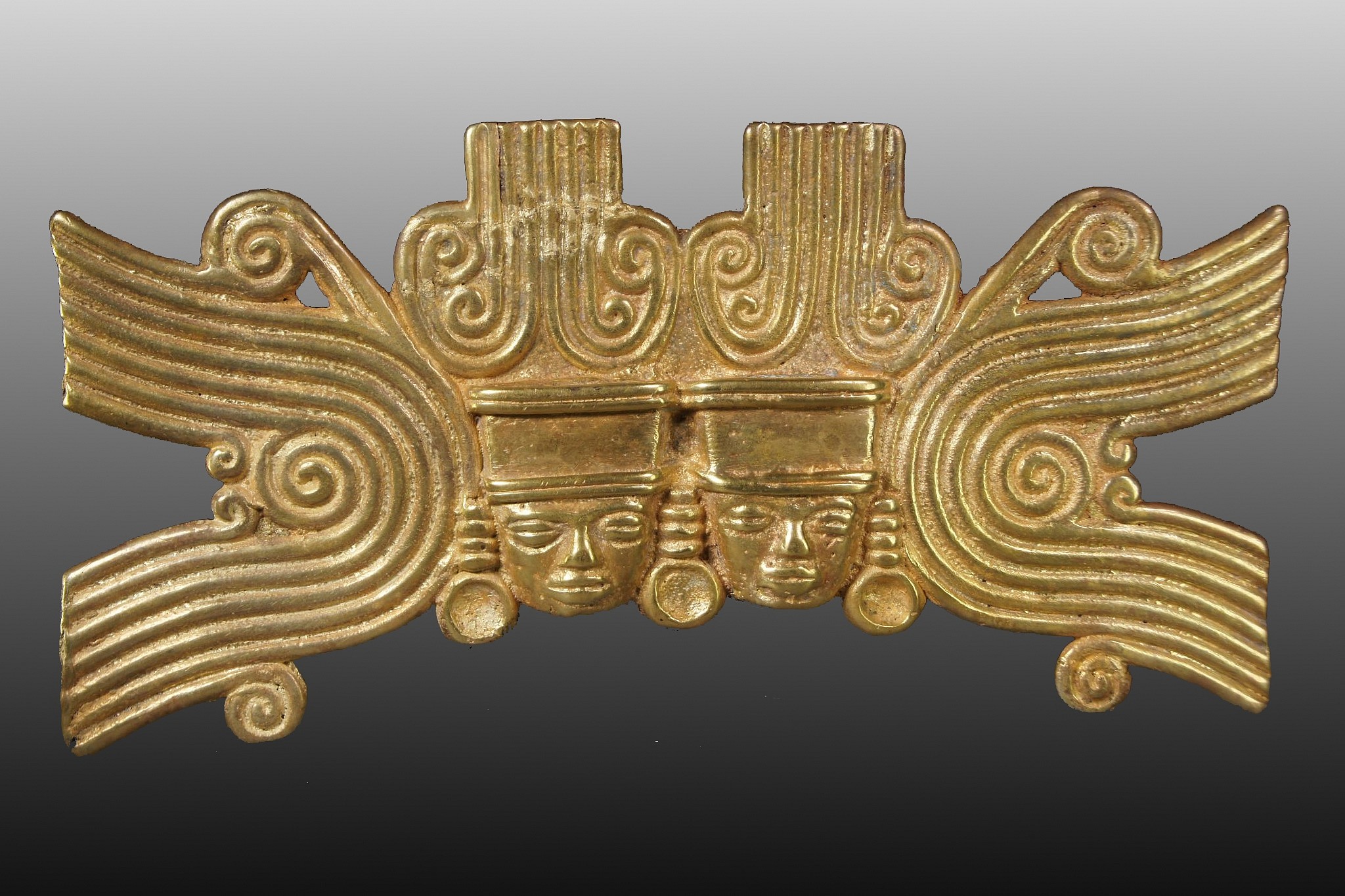






Colombia, Large Cast Gold Sinu Pendant with Two Royal Faces
This unique pendant features classic Quimbaya iconography. The design depicts twin faces side by side, wearing crowns and earring ornaments, with large spirals framing the twin faces on both sides. Twins were considered lucky in Pre-Columbian cultures. On the back are a pair of vertical suspension tubes. This ornament was found in the Uruba region on the Panamian border, an area of varied trade with neighboring cultures, especially the Sinu, Darien, and Quimbaya. Formally in the collection of a private Texas collector, prior to 1970. The top of upper right plumb was broken and soldered back together. Acquired from a Texas collector.
Period: Colombia, Gulf of Uruba, c. AD 500 - 1000
Media: Metal
Dimensions: Height: 4 1/4" x Width: 8 5/8" Weight: 282 grams.
$167,500
N6004








Colombia, Large Darien/Uruba Cast Gold Shaman
The Darien style is identified by the mushroom-shaped domes depicted atop the heads of shamanic figures. This male shaman is wearing a lunate nose ornament and has facial markings which may represent tattoos. He holds a bird in each hand, which could represent spiritual projection or physic flight. The spiral iconography is associated with the otherworld. The Uruba region borders Panama and was a major trading center with exposure to the stylistic traditions of surrounding cultures.
Period: Colombia, Gulf of Uruba, c. AD 500 - 1000
Media: Metal
Dimensions: Height: 6" x Width: 3 7/8" Weight: 199 grams.
$145,000
N8010b






Colombia, Muisca Cast Gold Erotic Male and Female
The female has her legs wrapped around a standing male as he holds her waist, creating the impression that the figures are engaged in sex. This sculpture has an ancient solid carbon core, which is still intact.From the Jan Mitchell collection, acquired prior to the 1970s, by descent to his sons.
Period: Colombia, Muisca, c. AD 700 - 1500
Media: Metal
Dimensions: Height: 3 3/8" x Width: 1" Weight: 30 grams.
$4,800
p1049





Colombia, Muisca Cast Gold Seated Warrior
This cast gold warrior holds a spear and spear thrower in one hand, and a slingshot in the other. He is wearing a hat, a necklace, and one remaining ear hoop. Contains an intact carbon core. From the Jan Mitchell collection, acquired prior to 1970, by descent to his sons.
Period: Colombia, Muisca, c. AD 700 - 1500
Media: Metal
Dimensions: Height: 1 5/8" Weight: 22.1 grams.
$3,500
p1051

Colombia, Narino Gold Disc Shaped Mirror with Single Suspension Hole
A similar disc is illustrated in The Art of Pre-Columbian Gold: The Jan Mitchell Collection. This disc is also from the Jan Mitchell collection, acquired prior to 1980.
Period: Ecuador, Narino, Southwestern, c. AD 1000 - 1200
Media: Metal
Dimensions: Diameter: 5 " Gram Weight: 56.9 grams.
$8,500
p3063




Colombia, Pair of Sinu Gold Ear Ornaments with Cutout Step Design
Around the outer rim is an embossed design. Each ornament is almost the same size and weight. Ex-Jan Mitchell collection, prior to 1970.
Period: Colombia, Sinu, Cauca River Valley, c. AD 1000 - 1500
Media: Metal
Dimensions: Diameter 5" each. Weight: 40.7grams & 40.4 grams.
Price Upon Request
P1004








Colombia, Pair of Sinu Gold Fan-Shaped Ear Ornaments (SOLD)
These beautiful lost-wax cast "False Filigree" style pendants each feature six sections of latticework separated by simple bands. The false filigree technique was favored by the Sinu goldsmiths. The larger the ornament, the higher the status of the wearer. These ear ornaments are illustrated in the Met Museum's Catalog, THE ART OF PRECOLUMBIAN GOLD: The Jan Mitchell Collection, pg. 164. Estate of Jan Mitchell, prior to 1970.
Period: Colombia, Sinu, Cauca River Valley, c. AD 1000 - 1500
Media: Metal
Dimensions: Height: 2 1/2" x Width: 4 3/8" Weight: 67.5 grams.
$27,000
p1022











Colombia, Quimbaya Cast Gold Pendant Depicting a Seated Queen in a Trance
This seated queen is elaborately dressed, to include a crown with 19 birds facing downwards, a U-shaped nose ornament, two sets of spiral-shaped ear ornaments, and a five-strand necklace. Her face is delicately sculptured with her eyes closed as if she were in a trance, and she holds a popuro in each hand. This is fine example of an early cast gold piece of good size. Similar pendants in museum collections include: the Museo del Oro in Bogota, the Museo de las Americas in Madrid, the Glassell Collection at the Houston Museum of Fine Arts, and the Dora Janssen Collection in Antwerp. Private Texas collection, prior to the 1970s.
Period: Colombia, Uruba N.W. Darian, circa AD1-700
Media: Metal
Dimensions: Height: 7" x Width: 2 1/4" Weight: 91.8 grams.
$145,000
N6009
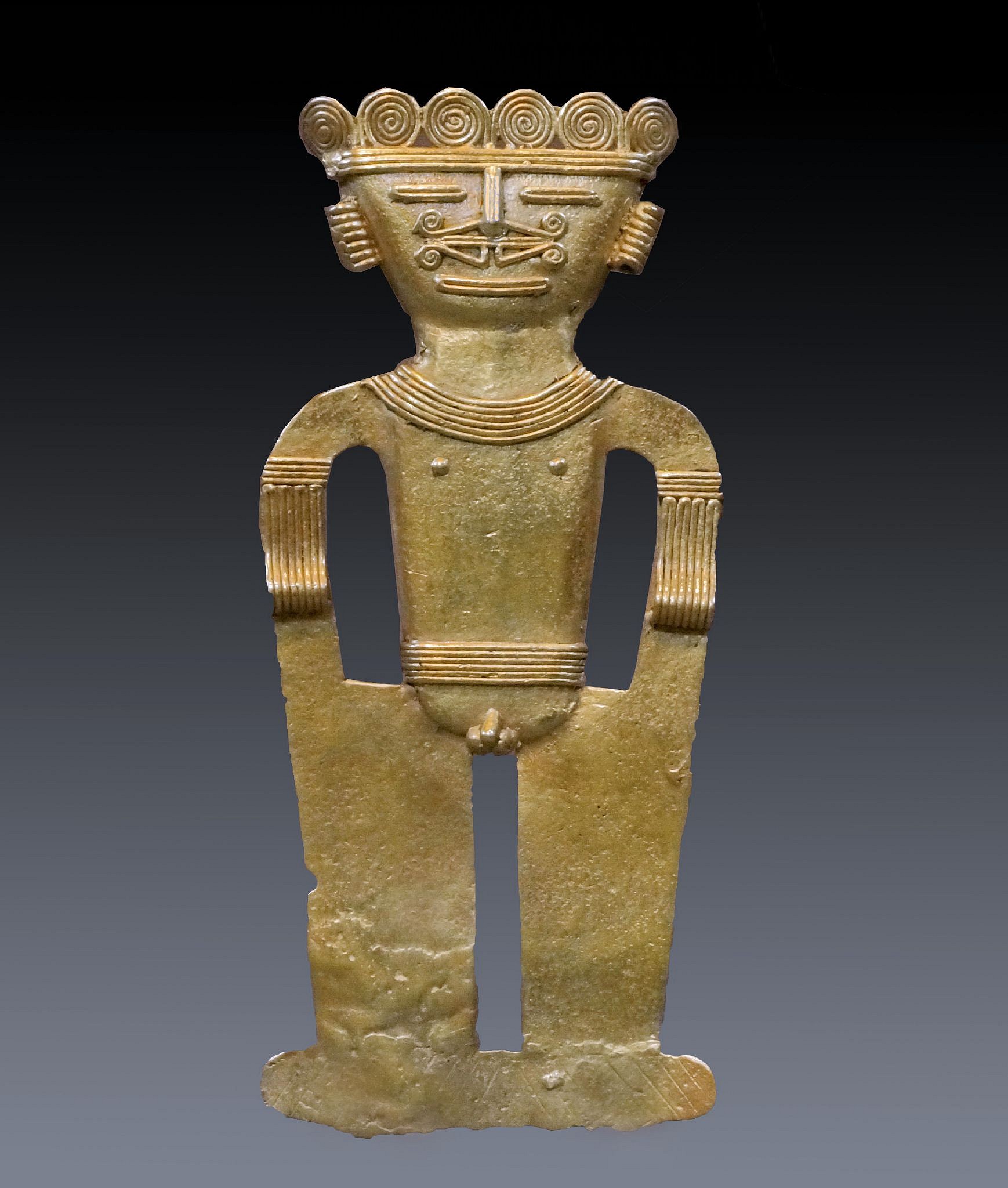



Colombia, Quimbaya cast gold pendant of a Lord in a Trance
The personage is wearing a crown, elaborate nose ornament, and necklace. He has an ancient casting repair to the lower left knee. The Uruba region is located on the Colombian/Panamanian border and had received early influences from the Quimbaya people and later influences from the Sinu. A similar pendant is illustrated in the article THE DARIEN GOLD PENDANTS OF ANCIENT COLOMBIA AND THE ISTHMUS, figure 35, and in the catalog of the Banco de Oro de Colombia # 414, Lam 46.
Period: Colombia, Gulf of Uruba, c. AD 500 - 1000
Media: Metal
Dimensions: Height: 6 3/8" ( 16.3cm) Weight 91.4 grams
XRF Au. 62% Ag. 22%, Cu16%
Price Upon Request
n4033










Colombia, Quimbaya Cast Gold Pendant of a Male Shaman
This is the largest known gold Quimbaya shaman. The shaman is in a state of trance or meditation, and wears elaborate ornaments, including: a crown with 24 birds facing downwards, a large pair of double-spiral ear ornaments, a crescent-shaped nose ornament, and a special gold necklace with a curly-tailed animal pendant. There are two suspension loops on the back. The casting is extremely well executed, with fine details on the crown and the necklace. A similar ornament is in the Museo del Oro and only measures 7 1/2" in height. A pair is illustrated in The Dora Janssen Collection catalogue, which measures 7 1/2" in height. Similar examples are also illustrated in MASTERWORKS OF PRE-COLUMBIAN GOLD: The Glassell Collections of The Museum of Fine Arts, Houston, p.151, and in The Art of Pre-Columbian Gold:The Jan Mitchell Collection, p.59. Similar examples are also published in The Gold of Eldorado, by Warwick Bray, on p. 218. From a Texas collector, acquired prior to the 1970s. Ex. Jan Mitchell collection, acquired prior to the 1980s by descent to his son David Mitchell.
Period: Colombia, Quimbaya, Uruba, Antioquia-c. AD 400 - 700
Media: Metal
Dimensions: Height" 8 1/2" x Width: 3 2/4" Weight: 192 grams.
$165,000
n7061
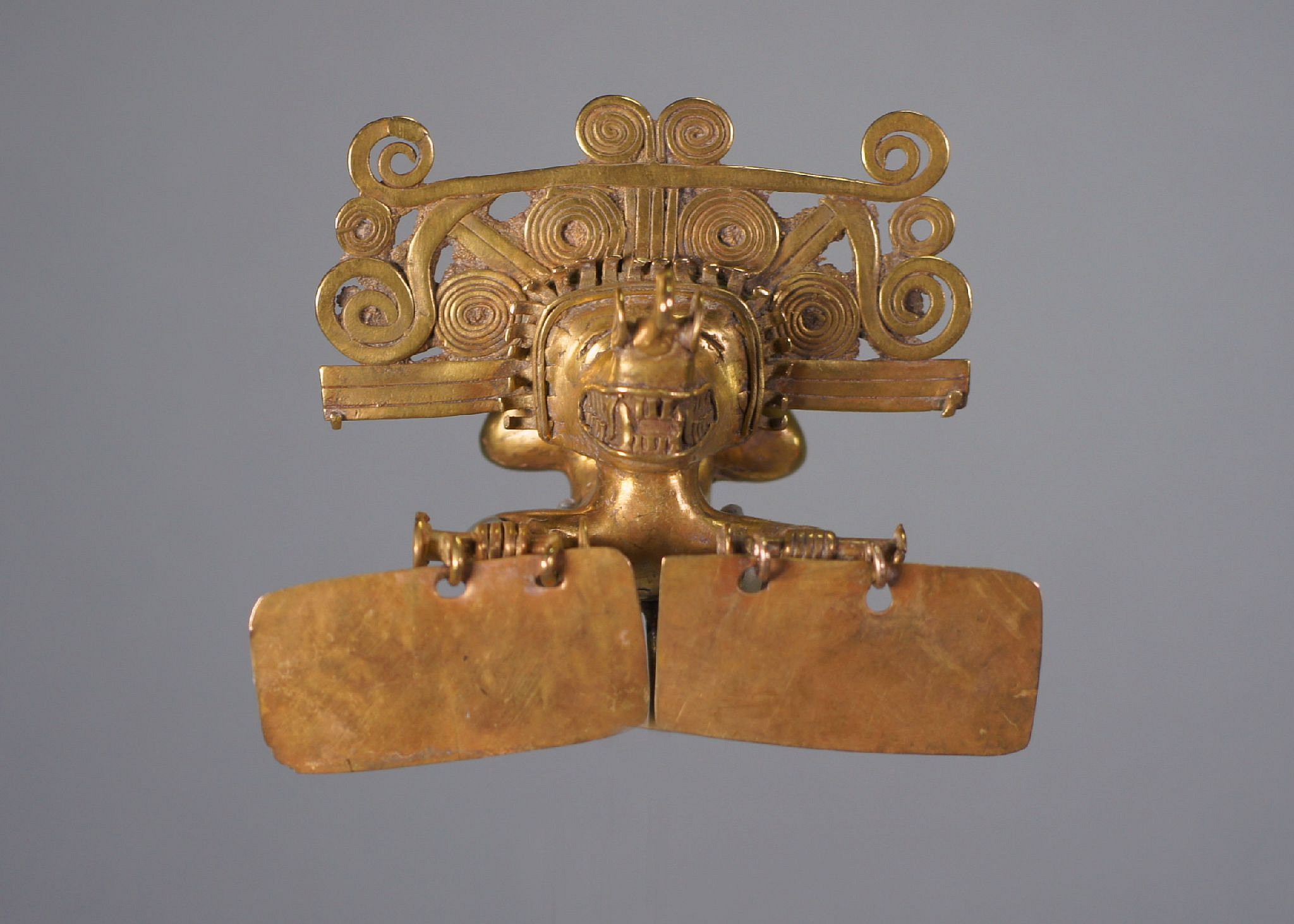


Colombia, Quimbaya Style Gold Pendant of a Tumbling Shaman with Two Rectangular Dangles
Cast figural pendant of a feline-headed Shaman tumbling in a trance. The shaman holds bars with large rectangles in each hand. This pendant is extremely well sculpted with curved limbs arching upward at the back, legs bent, and toes curled, with suspension loops on each sole. This example was purported to be found in the Uruba region of North West Colombia. The subject is a very rare subject for Colombian gold work.
Period: Colombia, Gulf of Uruba, c. AD 500 - 1000
Media: Metal
Dimensions: Width: 2 5/8 inches
Price Upon Request
99120
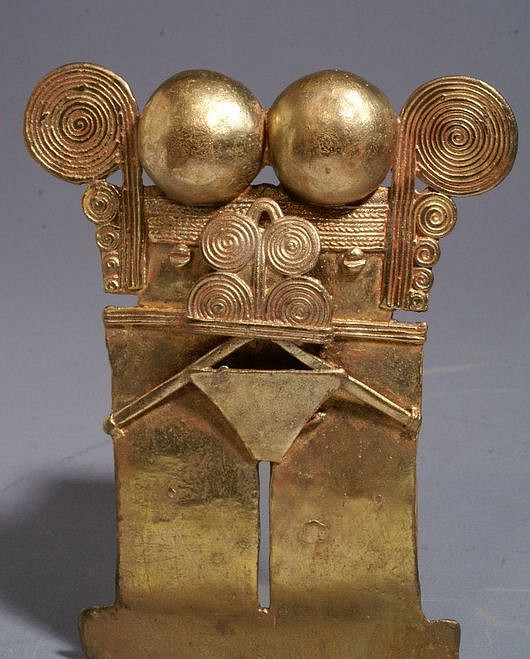


Colombia, Sinú Gold Pectoral of Mushroom Shaman in Trance
Called "Darien pectorals," these ornaments are one of the most fascinating and enigmatic in the corpus of Sinú gold work. They are not confined to one region, although their greatest concentration is in the Sinú area of northwestern Colombia, near the border with Panama's Darien Province. They are also found in the Quimbaya region of Colombia further south. The consensus of opinion on these pectorals is that they represent shamans in trance decorated with references to natural psychoactive hallucinogens (Shultes and Bright 1981, Reichel-Dolmatoff 1988). In this work and most such figures, the bell motifs above the face represent hallucinogenic mushrooms, and on some pieces, the mushrooms are realistically represented. Similarly, the mask of spiral curls in front of the face here is a stylized frog with hallucinogenic glands behind its eyes, but in some examples, the frog is completely realistic. Lastly, the vertical spirals on either side of the face are stylized bird wings, since shamans thought of their souls as flying to the otherworld to seek advice and knowledge from the ancestors and deity spirits.
Period: Colombia, Sinu, Northern Region, c. AD 400 - 1500
Media: Metal
Dimensions: Height: 4 1/2" x Width: 3 1/2" Weight 119 grams
Price Upon Request
M7027

Colombia, Sinu Solid Gold Nose Ring with End Caps
A solid gold U-shaped bent rod for a nose ornament with hammered end caps. Exhibited at The Museum of Primitive Art in 1969, no 165. Illustrated in The Art of Pre-Columbian Gold: The Jan Mitchell Collection, pages 162-163. Ex. Jan Mitchell collection, prior to 1980s, by descent to his sons.
Period: Colombia, Sinu,, c. AD 400 - 1500
Media: Metal
Dimensions: Diameter: 1 3/4" Weight: 31 grams.
$7,000
p1253





Colombia, Tairona Cacique With Bird Headdress
This is a small pendant of its type, a classic cacique wearing an elaborate headdress crafted with traditional swirls resembling animal heads in profile. The details are well done for such a small piece. Ex. Jan Mitchell collection, prior to the 1970s.
Period: Colombia, Tairona, Santa Marta c. AD 1000 - 1500
Media: Metal
Dimensions: Height 3 1/4" x Weight: 55.1 grams.
$18,000
P1003
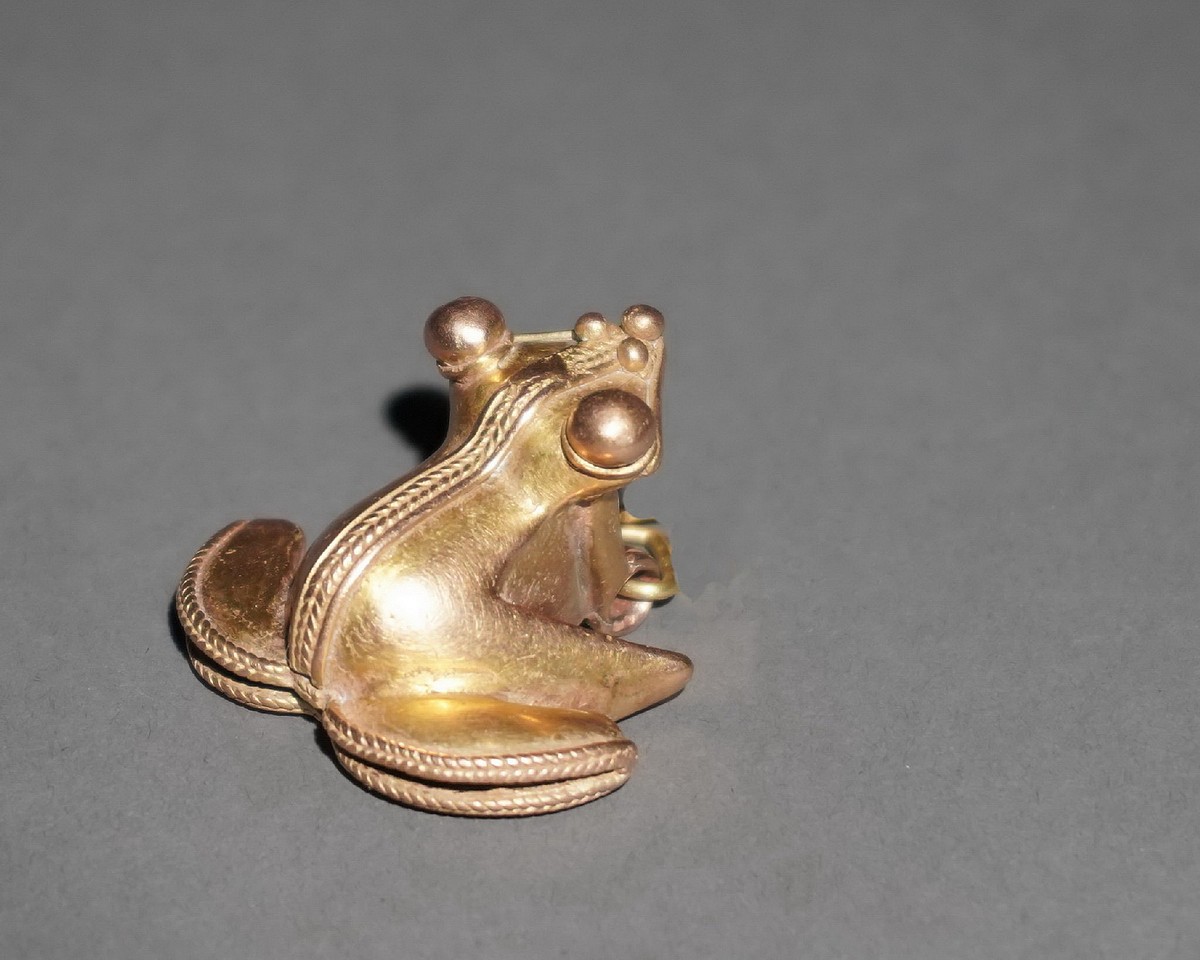





Colombia, Tairona Gold Cast Frog Pendant with Rattle
This expertly crafted gold pendant depicts a frog hunched on its back flippers. The frog has spherical eyes and a delicate braided ribbon that slopes down its back and borders its flippers. There is a modern suspension loop hung from the original suspension arrangement. Jan Mitchell collection prior to 1970, by descent to his sons.
Period: Colombia, Tairona, Santa Marta c. AD 1000 - 1500
Media: Metal
Dimensions: Length: 1 7/8" x Width: 1 5/8" Weight: 21.2 grams
Price Upon Request
p1045b





Colombia, Tairona Gold Cast Frog Pendant with Rattle
This expertly crafted gold pendant depicts a frog with large eyes hunched on its hind legs. A delicate braided ribbon slopes down its back and borders its legs. A modern suspension loop is attached to the original ancient suspension arrangement. From the Jan Mitchell collection, prior to 1970, by descent to his sons.
Period: Colombia, Tairona, Santa Marta c. AD 1000 - 1500
Media: Metal
Dimensions: Length: 1 7/8" x Width: 1 5/8" Weight: 21.2 grams.
$4,500
p1046
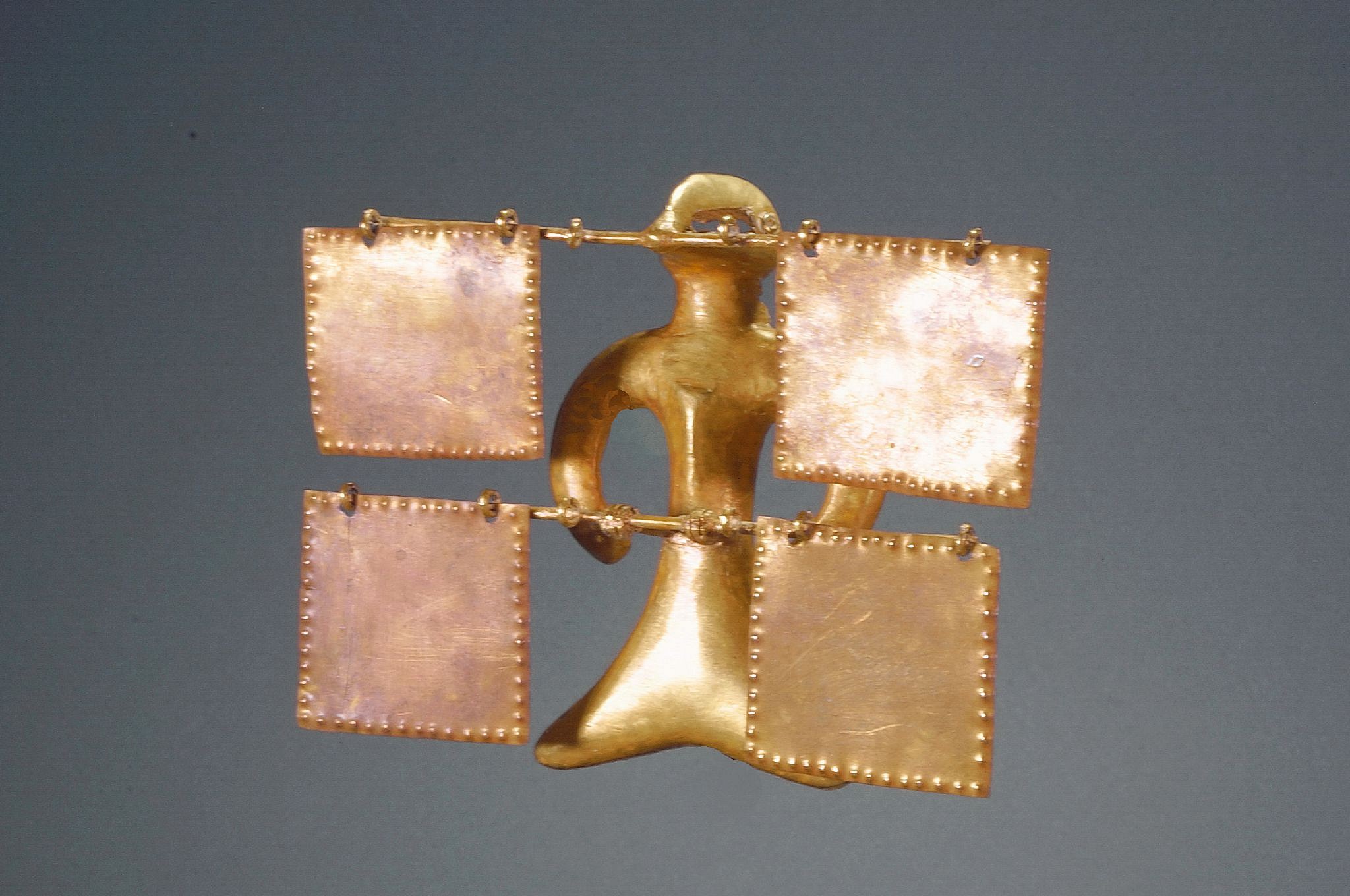



Colombia, Uruba Style Bird Pendant with Square Plaque Dangles
The bird has its wings arched to its sides, a flared tail, and four dangles suspended on two bars. The small suspension holes are inside the back of the neck. The bird has bead-like eyes and is a generalized composite of various birds. This piece is well cast, with evidence of the carbon core intact. There is a similar bird in The Gold Museum of Colombia in Bogota. Ex. Louisiana professor acquired prior to 1980s'.
Period: Colombia, Gulf of Uruba, c. AD 500 - 1000
Media: Metal
Dimensions: Height: 3 1/2" x Width: 4 1/2" Weight 33.6 grams.
$12,500
MM068
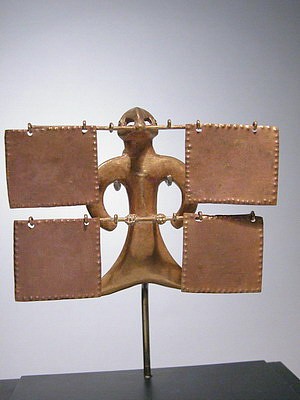
Colombia, Uruba style bird pendent with square plaque dangles
The bird has its wings arched to its sides and a flared tail and 4 dangles suspended on 2 bars. The suspension holes are small, inside the neck and two bead like eyes. The bird is a generalized composite of various birds, representing none in particular. It is well cast with evidence of the carbon core intact. There is a similar bird in The Gold Museum of Colombia in Bogota of the same size and posted on their website http://www.banrep.gov.co/museo/esp/o_uraba_O32654C.htm
Period: Colombia, Gulf of Uruba, c. AD 500 - 1000
Media: Metal
Dimensions: Height 3 1/2" x Width 4 1/2" Weight 33.6 grams
Price Upon Request
MM608





